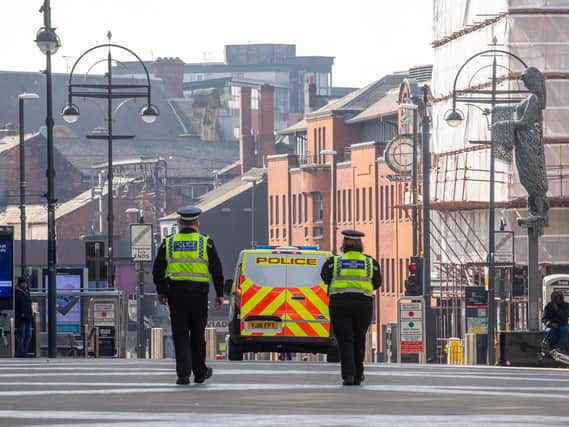New Tiers and Yorkshire: What Tier am I in? Tier 3 latest as West Yorkshire escapes Tier 4 lockdown and North Yorkshire moves up from Tier 2


Speaking to Commons, Matt Hancock said that the areas in Yorkshire already under Tier 3 restrictions will remain in the 'Very High' alert level.
This means West Yorkshire will remain under Tier 3 restrictions at least until the next tier review.
Advertisement
Hide AdAdvertisement
Hide AdNorth Yorkshire, which has been in Tier 2 since the national lockdown ended, will also now move up to Tier 3.
The Tier 3 'Very High' alert level restrictions have been in place in the whole of Yorkshire excluding North Yorkshire since the second national lockdown ended on December 2.
Today's announcement means that across Yorkshire household mixing is banned anywhere indoors but two households can mix in limited circumstances in parks and fields, but only if observing the rule of six.
Non-essential shops can remain open, along with personal care salons, such as hairdressers, and leisure facilities such as gyms.
Advertisement
Hide AdAdvertisement
Hide AdHospitality venues will be closed to diners, however, but will be allowed to stay open for takeaway or delivery.
Yorkshire will not be joining London, the South East and the East of England who are already living under the highest level of restrictions in Tier 4, and the other 23 areas which will move up from tomorrow.
Which parts of Yorkshire are changing Tier or going into Tier 3?
The following local authority areas will move to Tier 3 from Thursday, according to the Department of Health.
– Rutland
– Shropshire and Telford & Wrekin
Advertisement
Hide AdAdvertisement
Hide Ad– Worcestershire (Bromsgrove, Malvern Hills, Redditch, Worcester, Wychavon, Wyre Forest)
– Herefordshire
– Liverpool City Region (Halton, Knowsley, Liverpool, Sefton, Wirral, St Helens)
– York and North Yorkshire (Scarborough, Hambleton, Richmondshire, Selby, Craven, Ryedale, Harrogate, City of York)
– Bath and North East Somerset
– Devon, Plymouth, Torbay (East Devon, Exeter, Mid Devon, North Devon, South Hams, Teignbridge, Torridge, West Devon, Plymouth, Torbay)
– Cornwall
– Dorset
– Wiltshire
Advertisement
Hide AdAdvertisement
Hide AdThe areas to go into Tier 4, according to the Department of Health, are:
– the city of Leicester
– Leicestershire (Oadby and Wigston, Harborough, Hinckley and Bosworth, Blaby, Charnwood, North West Leicestershire, Melton)
– Lincolnshire (City of Lincoln, Boston, South Kesteven, West Lindsey, North Kesteven, South Holland, East Lindsey)
Advertisement
Hide AdAdvertisement
Hide Ad– Northamptonshire (Corby, Daventry, East Northamptonshire, Kettering, Northampton, South Northamptonshire, Wellingborough)
– Derby and Derbyshire (Derby, Amber Valley, South Derbyshire, Bolsover, North East Derbyshire, Chesterfield, Erewash, Derbyshire Dales, High Peak)
– Nottingham and Nottinghamshire (Gedling, Ashfield, Mansfield, Rushcliffe, Bassetlaw, Newark and Sherwood, Broxtowe)
– Birmingham and Black Country (Dudley, Birmingham, Sandwell, Walsall, Wolverhampton)
– Coventry
– Solihull
Advertisement
Hide AdAdvertisement
Hide Ad– Warwickshire (Rugby, Nuneaton and Bedworth, Warwick, North Warwickshire, Stratford-upon-Avon)
– Staffordshire and Stoke-on-Trent (East Staffordshire, Stafford, South Staffordshire, Cannock Chase, Lichfield, Staffordshire Moorlands, Newcastle under Lyme, Tamworth, Stoke-on-Trent)
– Lancashire (Burnley, Pendle, Blackburn with Darwen, Ribble Valley, Blackpool, Preston, Hyndburn, Chorley, Fylde, Lancaster, Rossendale, South Ribble, West Lancashire, Wyre)
– Cheshire and Warrington (Cheshire East, Cheshire West and Chester, Warrington)
Advertisement
Hide AdAdvertisement
Hide Ad– Cumbria (Eden, Carlisle, South Lakeland, Barrow-in-Furness, Copeland, Allerdale)
– Greater Manchester (Bolton, Bury, Manchester, Oldham, Rochdale, Salford, Stockport, Tameside, Trafford, Wigan)
– Tees Valley (Darlington, Hartlepool, Middlesbrough, Redcar and Cleveland, Stockton-on-Tees )
– North East (County Durham, Gateshead, Newcastle-upon-Tyne, North Tyneside, Northumberland, South Tyneside, Sunderland)
Advertisement
Hide AdAdvertisement
Hide Ad– Gloucestershire (Gloucester, Forest of Dean, Cotswolds, Tewkesbury, Stroud, Cheltenham)
– Somerset Council (Mendip, Sedgemoor, Somerset West and Taunton, South Somerset)
– Swindon
– Bournemouth, Christchurch and Poole
– Isle of Wight
– New Forest
When will Tier 3 be reviewed?
The Tiers are reviewed every two weeks, so Leeds will not be able to either move down to Tier 2 or be pushed up to Tier 4 until at least January 13.
That means that bars and pubs will have to stay closed to customers and household mixing remains banned inside and in gardens.
Advertisement
Hide AdAdvertisement
Hide AdWhat are the Tier 3 restrictions in full for Yorkshire in full?
- Household mixing is banned anywhere indoors
- Two households can mix in limited circumstances in parks and fields, but only if observing the rule of six
- Non essential shops can open
- Pubs, bars and restaurants cannot open their doors - they must operate for collection and delivery only
- People in Tier 3 are advised not to travel outside their area
Advertisement
Hide AdAdvertisement
Hide Ad- Hotels must close and overnight stays outside the local area are not permitted
- Wedding receptions are banned in Tier 3 areas but ceremonies can go ahead with 15 guests
- Funerals will allow up to 30 guests only
- Large sport events are banned from taking place but drive-in events like drive-in cinemas are allowed
What are the Covid infection rates across Leeds?
Since the first data sets published after Christmas, Leeds has seen a day on day rise in infection rates.
Advertisement
Hide AdAdvertisement
Hide AdOn December 29, the Covid rate in Leeds was published as 189.8 cases per 100,000 people.
This is at a positivity rate of 7.3 per cent.
This represents a 2.7 per cent increase in case rates since the previous case rate figures, 184.8 per 100,000 people, were issued on December 27 with a positivity rate of 6.9 per cent.
These are the Leeds areas where the Covid rates are growing the fastest.
The changes come as the Oxford/ AstraZeneca vaccine has been approved for mass rollout.